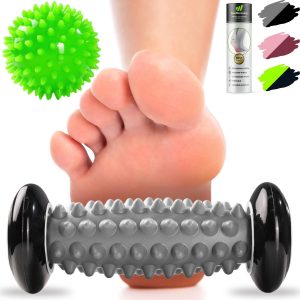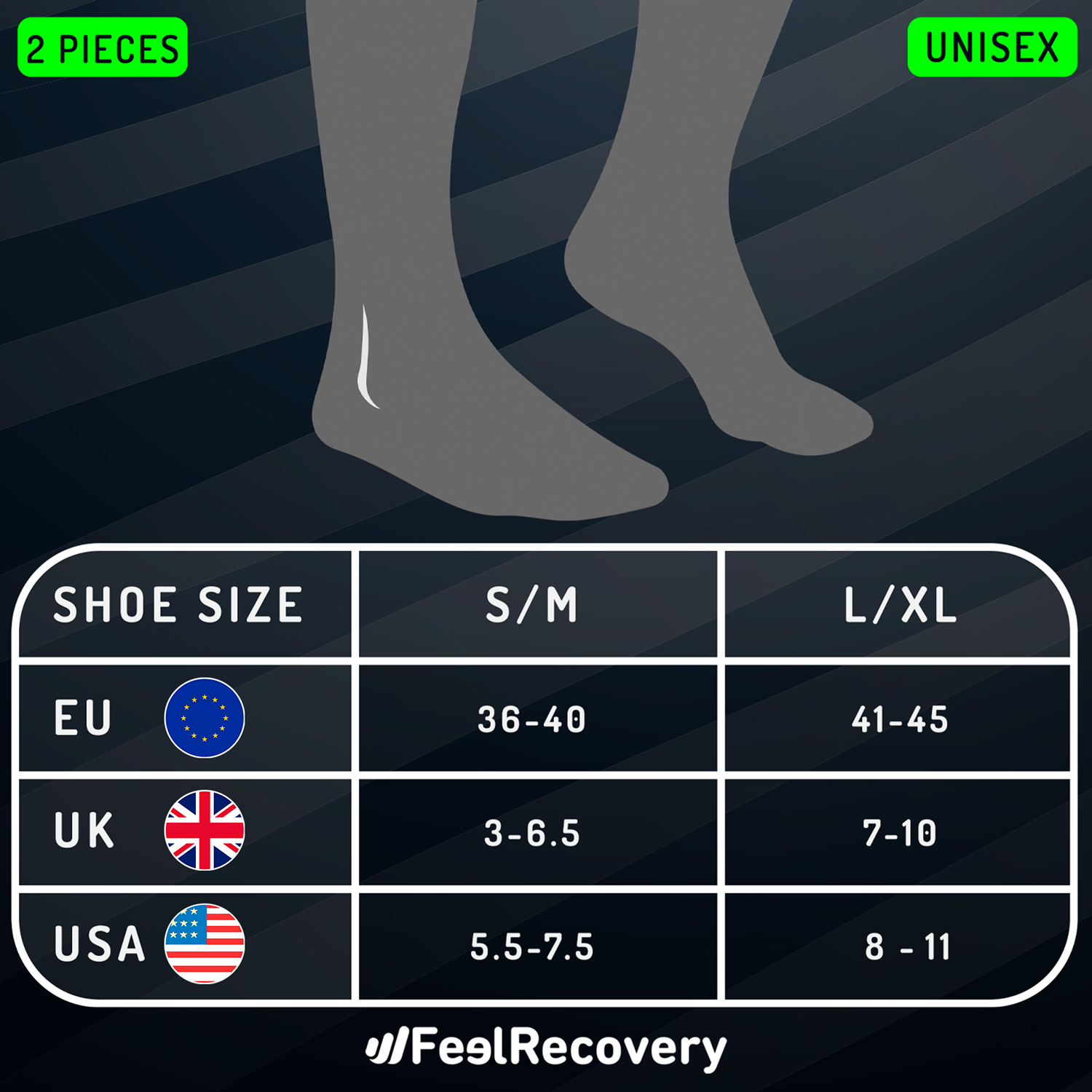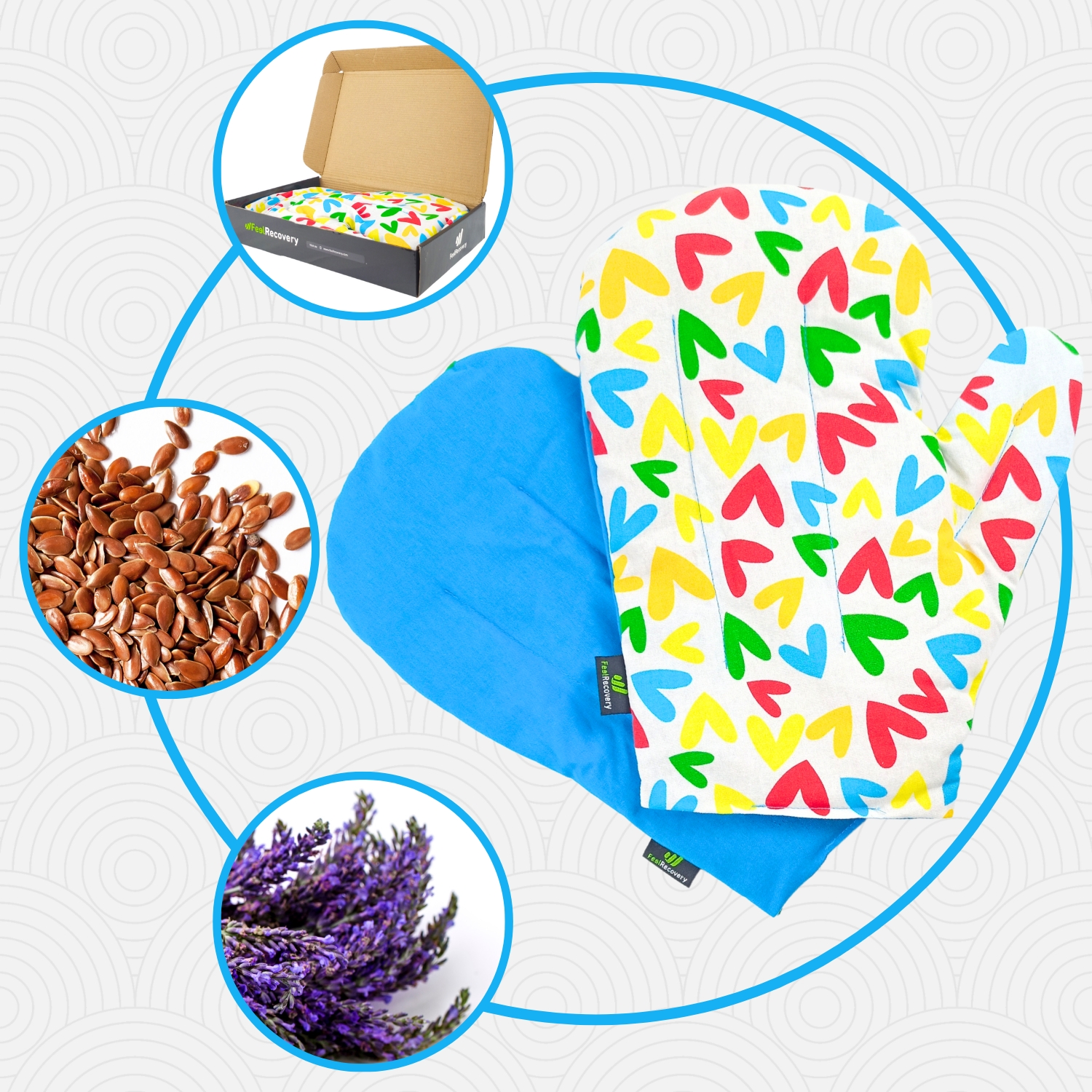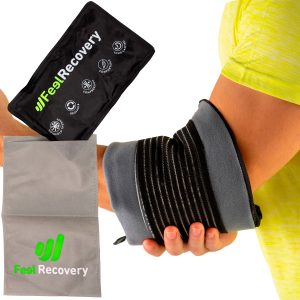Passive recovery methods, such as massage, stretching, and foam rolling, are important for promoting recovery after workouts because they help to reduce muscle soreness, improve range of motion, and increase blood flow to the muscles. When we exercise, we create small tears in our muscle fibers, which leads to inflammation and soreness.
Can help to reduce this inflammation and promote healing, which can lead to faster recovery and improved performance. Additionally, these methods can help to prevent injury by improving flexibility and reducing muscle tension. Overall, incorporating passive recovery methods into a workout routine can improve recovery and performance, making them an important component of any fitness program.
Best products for passive recovery
bestseller
-
2 Knee Compression Sleeve (Black/Gray)
£17,50 -
2 Knee Compression Sleeve (Green/Navy)
£17,50 -
2 Knee Compression Sleeve (Pink/Bordeaux)
£17,50 -
2 Thigh Compression Sleeve (Black/Gray)
£17,50 -
2 Thigh Compression Sleeve (Green/Navy)
£17,50 -
2 Thigh Compression Sleeve (Pink/Bordeaux)
£17,50 -
Acupressure Mat and Pillow (Black/Gray)
£44,95 -
Acupressure Mat and Pillow (Green/Navy)
£44,95 -
Acupressure Mat and Pillow (Pink/Bordeaux)
£44,95 -
Acupressure Pillow (Black/Gray)
£21,52 -
Acupressure Pillow (Green/Navy)
£21,52 -
Acupressure Pillow (Pink/Bordeaux)
£21,52 -
Foot Massage Roller for Plantar Fasciitis (Black)
£17,50 -
Foot Massage Roller for Plantar Fasciitis (Green)
£17,50 -
Foot Massage Roller for Plantar Fasciitis (Pink)
£17,50 -
Gel Eye Mask for Puffy Eyes (Gold/Black)
£9,95 -
Gel Eye Mask for Puffy Eyes (Orange/Pink)
£9,95 -
Gel Eye Mask for Puffy Eyes (Purple/Turquoise)
£9,95 -
Ice Massage Roller Ball (Black)
£34,95 -
Ice Massage Roller Ball (Green)
£34,95 -
Ice Massage Roller Ball (Pink)
£34,95 -
Ice Pack for Foot - Cold Therapy Socks (Black)
£21,95 -
Ice Pack for Foot - Cold Therapy Socks (Green)
£21,95 -
Ice Pack for Foot - Cold Therapy Socks (Pink)
£21,95 -
Microwavable Heated Slippers (Hearts)
£21,50 -
Microwavable Heated Slippers (Oxford)
£21,50 -
Microwavable Heated Slippers (Sport)
£21,50 -
Microwave Arthritis Gloves (2 Mittens) (Hearts)
£25,50 -
Microwave Arthritis Gloves (2 Mittens) (Oxford)
£25,50 -
Microwave Wheat Bag for Back Pain Relief (Extra Large) (Hearts)
£25,50 -
Microwave Wheat Bag for Back Pain Relief (Extra Large) (Oxford)
£25,50 -
Microwave Wheat Bag for Back Pain Relief (Extra Large) (Sport)
£25,50 -
Microwave Wheat Bag for Neck & Shoulder Pain Relief (Hearts)
£21,50 -
Microwave Wheat Bag for Neck & Shoulder Pain Relief (Oxford)
£21,50 -
Microwave Wheat Bag for Neck & Shoulder Pain Relief (Sport)
£21,50 -
Microwave Wheat Bag for Neck Pain Relief (Hearts)
£17,50 -
Microwave Wheat Bag for Neck Pain Relief (Oxford)
£17,50 -
Microwave Wheat Bag for Neck Pain Relief (Sport)
£17,50 -
Microwaveable Wheat Bag for Pain Relief (Hearts)
£17,50 -
Microwaveable Wheat Bag for Pain Relief (Oxford)
£17,50 -
Microwaveable Wheat Bag for Pain Relief (Sport)
£17,50 -
Pack 2 in 1: Foam Roller High + Soft Density (Black/Gray)
£24,95 -
Pack 2 in 1: Foam Roller High + Soft Density (Green/Navy)
£24,95 -
Pack 2 in 1: Foam Roller High + Soft Density (Pink/Bordeaux)
£24,95 -
Sacroiliac Support Belt (Black)
£21,95 -
Sacroiliac Support Belt (Green)
£21,95 -
Sacroiliac Support Belt (Pink)
£21,95 -
Shoulder Support Brace (Black)
£21,95 -
Shoulder Support Brace (Green)
£21,95 -
Shoulder Support Brace (Pink)
£21,95 -
Soft Density Foam Roller for Recovery (Black)
£24,95 -
Soft Density Foam Roller for Recovery (Green)
£24,95 -
Soft Density Foam Roller for Recovery (Pink)
£24,95 -
Wheat Bag for Microwave Classic Bottle Shaped (Hearts)
£17,50 -
Wheat Bag for Microwave Classic Bottle Shaped (Oxford)
£17,50 -
Wheat Bag for Microwave Classic Bottle Shaped (Sport)
£17,50
What is passive recovery?
Are techniques that allow the body to recover without actively engaging in physical activity. These methods can include techniques such as massage, stretching, ice or heat therapy, and compression garments.
Recovery is crucial for athletic performance because it allows the body to repair and rebuild after exercise. During exercise, the body experiences stress and damage to the muscles and tissues, and recovery allows for the repair and rebuilding of these structures.
Without proper recovery, athletes are at risk of overtraining, decreased performance, and increased risk of injury. Additionally, recovery can help to reduce inflammation, soreness, and fatigue, allowing athletes to perform at their best during their next training session or competition.
Types of passive recovery methods
Here is a list of the best types of passive recovery methods:
- Sleep and rest: Getting enough sleep and rest is crucial for recovery as it allows your body to repair and rejuvenate itself.
- Massage therapy: Massage therapy helps to improve blood circulation, reduce muscle tension, and promote relaxation, which can aid in recovery.
- Contrast therapy: Contrast therapy involves alternating between hot and cold therapies to promote blood flow, reduce inflammation, and aid in recovery.
- Compression therapy: Compression therapy involves using compression garments or devices to apply pressure to the muscles, which can help to improve blood flow, reduce swelling, and aid in recovery.
- Foam rolling: Foam rolling is a form of self-myofascial release that involves using a foam roller to apply pressure to specific areas of the body to release tension and improve mobility.
- Hydrotherapy: Hydrotherapy involves using water, such as hot tubs, pools, or ice baths, to aid in recovery by reducing inflammation, improving circulation, and promoting relaxation.
- Yoga and stretching: Yoga and stretching can help to increase flexibility, reduce muscle tension, and promote relaxation, all of which can aid in recovery.
- Mind-body practices: Mind-body practices, such as meditation or deep breathing, can help to reduce stress and promote relaxation, which can aid in recovery.
- Sauna: Saunas can be an effective method for sports recovery. The high temperature in the sauna causes the blood vessels to dilate, increasing blood flow and promoting relaxation. This can help to reduce muscle soreness and stiffness, while also providing a cardiovascular benefit.
These passive recovery methods can be used individually or in combination to help you recover faster and perform better in your physical activities. It's important to note that while can be helpful, they should not be used as a substitute for proper rest and recovery, including adequate nutrition, hydration, and sleep.
Benefits of passive recovery methods
Here are some benefits of passive recovery methods:
- Reduces muscle soreness and fatigue: Such as massage therapy, compression therapy, and foam rolling can help to reduce muscle soreness and fatigue after exercise.
- Improves circulation: Such as contrast therapy and compression therapy, can help to improve blood circulation, which can aid in recovery.
- Reduces inflammation: Such as hydrotherapy and contrast therapy, can help to reduce inflammation, which can improve recovery time and reduce the risk of injury.
- Promotes relaxation: Many passive recovery methods, such as massage therapy, yoga, and mind-body practices, can promote relaxation, which can reduce stress and improve recovery.
- Increases flexibility: Such as stretching and yoga can help to increase flexibility, which can improve range of motion and reduce the risk of injury.
- Aids in injury prevention: Can help to reduce the risk of injury by improving circulation, reducing inflammation, and promoting relaxation.
- Enhances performance: By reducing muscle soreness and fatigue, improving circulation, and promoting relaxation, can help to enhance performance in physical activities.
- Promotes better sleep: Such as yoga and meditation, can help to improve sleep quality, which can aid in recovery.
How to incorporate passive recovery into your routine?
Incorporating passive recovery into your routine is an important step in promoting overall health and well-being. Here are a few steps to help you create a recovery plan that works for you:
- Identify which passive recovery methods work best for you: Experiment with different recovery methods, such as massage therapy, foam rolling, or contrast therapy, and determine which ones work best for your body and your recovery needs.
- Schedule recovery time into your training plan: Make recovery a priority by scheduling recovery time into your training plan. This could include rest days, active recovery workouts, or specific time periods dedicated to recovery methods.
- Create a recovery plan: Develop a recovery plan that incorporates the passive recovery methods that work best for you. This may include a combination of methods, such as foam rolling and compression therapy, that are designed to target specific areas of the body.
- Be consistent: Consistency is key when it comes to recovery. Incorporate your recovery plan into your overall routine and stick with it over time to see the best results.
- Listen to your body: Pay attention to your body's cues and adjust your recovery plan as needed. If a particular method is causing discomfort or not producing the desired results, consider trying a different approach.
F.A.Q: Frequently asked questions
References
- Dupont, G., Blondel, N., & Berthoin, S. (2003). Performance for short intermittent runs: active recovery vs. passive recovery. European journal of applied physiology, 89(6), 548-554. https://link.springer.com/article/10.1007/s00421-003-0834-2
- Choi, D., Cole, K. J., Goodpaster, B. H., Fink, W. J., & Costill, D. L. (1994). Effect of passive and active recovery on the resynthesis of muscle glycogen. Medicine and science in sports and exercise, 26(8), 992-996. https://europepmc.org/article/med/7968434
- Menzies, P., Menzies, C., McIntyre, L., Paterson, P., Wilson, J., & Kemi, O. J. (2010). Blood lactate clearance during active recovery after an intense running bout depends on the intensity of the active recovery. Journal of sports sciences, 28(9), 975-982. https://www.tandfonline.com/doi/full/10.1080/02640414.2010.481721
- Cullen, M. F. L., Casazza, G. A., & Davis, B. A. (2021). Passive recovery strategies after exercise: a narrative literature review of the current evidence. Current Sports Medicine Reports, 20(7), 351-358. https://journals.lww.com/acsm-csmr/fulltext/2021/07000/passive_recovery_strategies_after_exercise__a.5.aspx
- Tessitore, A., Meeusen, R., Pagano, R., Benvenuti, C., Tiberi, M., & Capranica, L. (2008). Effectiveness of active versus passive recovery strategies after futsal games. The Journal of Strength & Conditioning Research, 22(5), 1402-1412. https://journals.lww.com/nsca-jscr/Fulltext/2008/09000/Effectiveness_of_Active_Versus_Passive_Recovery.3.aspx
- Bond, V., Adams, R. G., Tearney, R. J., Gresham, K., & Ruff, W. (1991). Effects of active and passive recovery on lactate removal and subsequent isokinetic muscle function. The Journal of sports medicine and physical fitness, 31(3), 357-361. https://europepmc.org/article/med/1798305
- Gupta, S., Goswami, A., Sadhukhan, A. K., & Mathur, D. N. (1996). Comparative study of lactate removal in short term massage of extremities, active recovery and a passive recovery period after supramaximal exercise sessions. International journal of sports medicine, 17(02), 106-110. https://www.thieme-connect.com/products/ejournals/abstract/10.1055/s-2007-972816
- Dupont, G., Moalla, W., Guinhouya, C., Ahmaidi, S., & Berthoin, S. (2004). Passive versus active recovery during high-intensity intermittent exercises. Medicine & Science in Sports & Exercise, 36(2), 302-308. https://paulogentil.com/pdf/Passive%20versus%20Active%20Recovery%20during%20High-Intensity%20Intermittent%20Exercises.pdf
- Rey, E., Padrón-Cabo, A., Costa, P. B., & Barcala-Furelos, R. (2019). Effects of foam rolling as a recovery tool in professional soccer players. The Journal of Strength & Conditioning Research, 33(8), 2194-2201. https://journals.lww.com/nsca-jscr/FullText/2019/08000/Effects_of_Foam_Rolling_as_a_Recovery_Tool_in.18.aspx
- Davies, V., Thompson, K. G., & Cooper, S. M. (2009). The effects of compression garments on recovery. The Journal of Strength & Conditioning Research, 23(6), 1786-1794. https://journals.lww.com/nsca-jscr/Fulltext/2009/09000/The_Effects_of_Compression_Garments_on_Recovery.23.aspx


























































































































